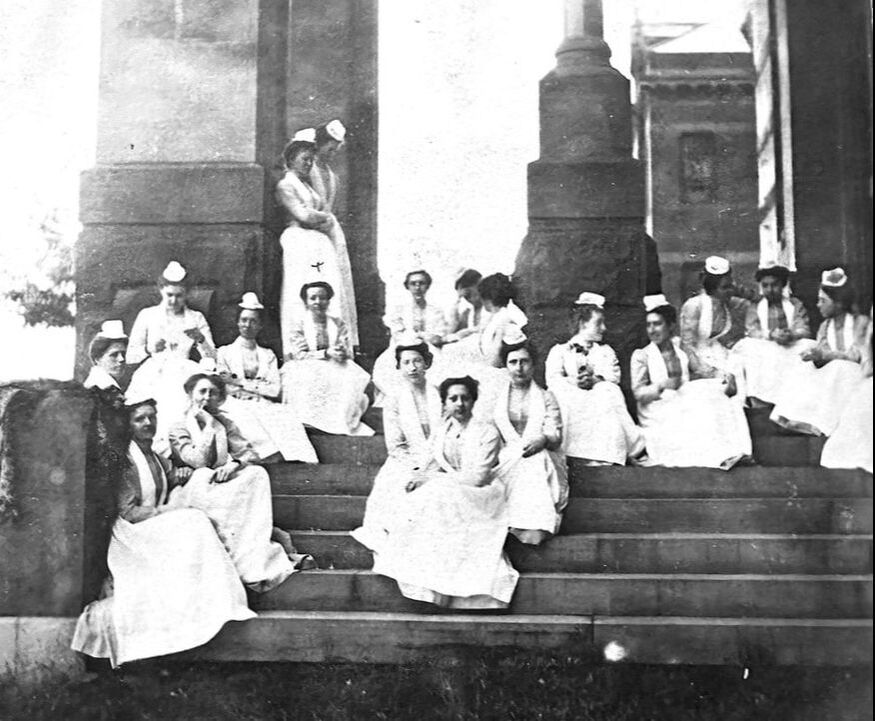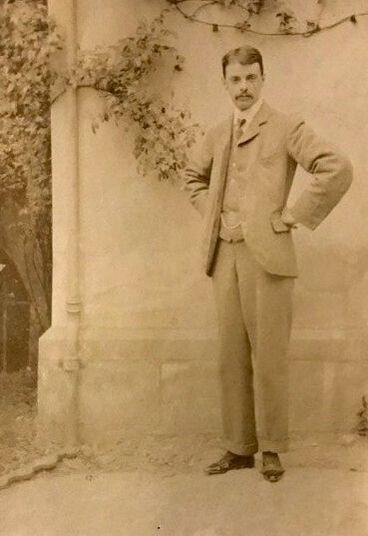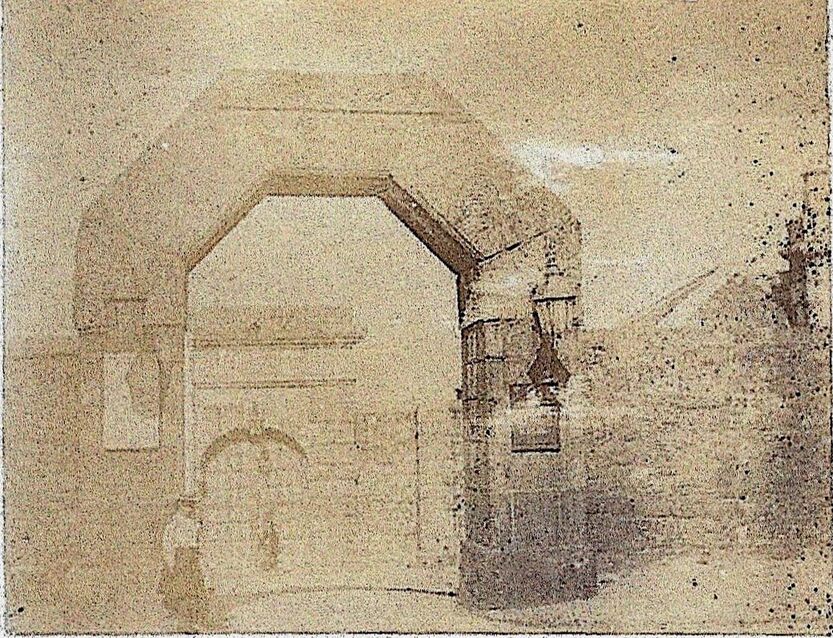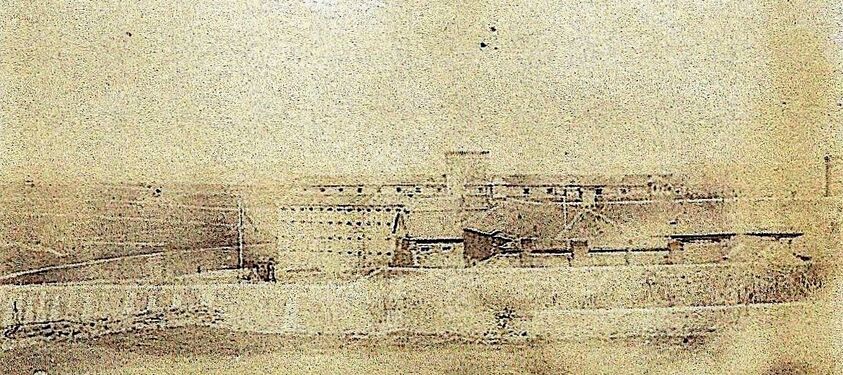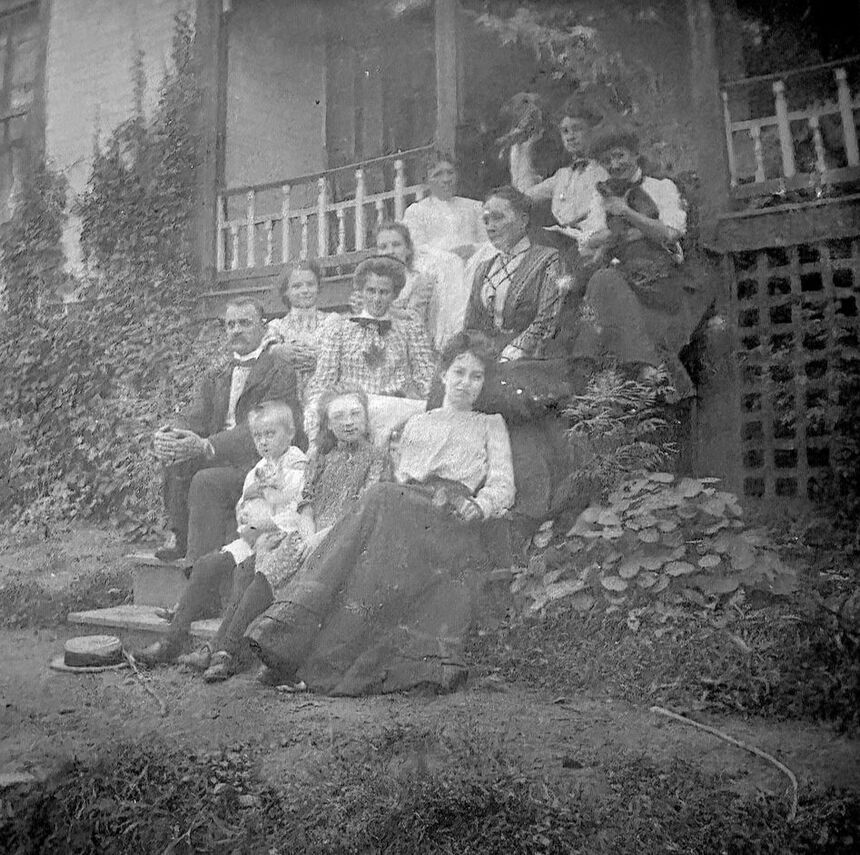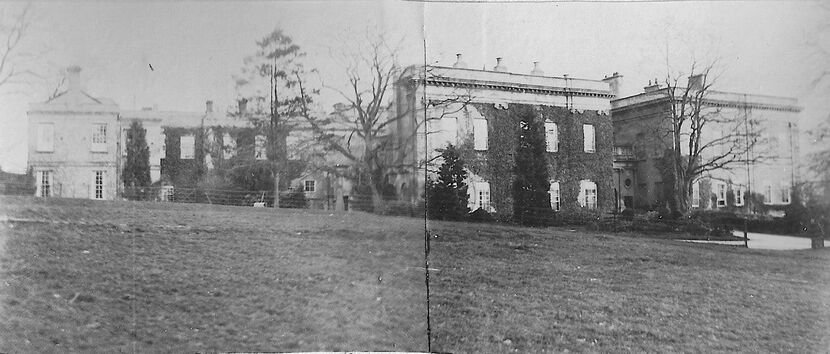Jack Walters’ Missing Years Research Angela Walters and Dr Peter Carpenter October 2023
All photographs courtesy Walters family
All photographs courtesy Walters family
In the last issue we published the story of Dr Jack Walters who worked at Kingsdown Mental Asylum for a while before the
First World War. The story seemed complete but Dr Peter Carpenter raised some rather simple questions which sparked research into some entirely overlooked episodes in Jack’s life.
First World War. The story seemed complete but Dr Peter Carpenter raised some rather simple questions which sparked research into some entirely overlooked episodes in Jack’s life.
Unexplained Questions
Peter raised two specific points about the previous article which he found to be unusual and needed further research and explanations despite the original article appearing to be complete:
Peter raised two specific points about the previous article which he found to be unusual and needed further research and explanations despite the original article appearing to be complete:
- Jack seems to have taken seven years to complete what was a five-year course to get his two qualifications of the lic RCPhys (licentiate of the Royal College of Psychiatrists) and MRCSurg (Member of the Royal College of Surgeons) in 1899. It was at this point that he was able to register as a doctor with the General Medical Council in July 1899.
- At times, Jack worked in the private medical sector like most people in psychiatry but then moved briefly into county asylums where there was a reasonably established training pathway. After working at Kingsdown House, he then moved to Bailbrook House even though both were a similar size, well established, and effectively run nursing homes undertaking the same type of work. I wonder why?
|
Training Time
Peter Carpenter commented: I am intrigued that he took seven years to qualify, from 1892 to 1899. The GMC had in 1890 extended the medical course training length to five years, with little clinical work and a lot more science. It sounds as though he had an equivalent to a MB part 1, then part 2 then final exams which are the LRCP and MRCS which are not hospital exams. The research by Angela and Peter into the timeline of Jack during his training period eventually threw up these details: 1892 – started training at Guys 1893 29 April - passed the boards exams in elementary biology part III elementary anatomy part IV 1893-94 – passed chemistry and physics exams 1894 July to October – visited his family in USA.[1] 1895 12 January - passed in anatomy and physiology and visited New York 1895 April - visited Dartmoor Prison 1896 - went to Paris 1897 November to 1898 May – visited family in Florida.[2] 1899 – qualified. |
Work at Dartmoor Prison
There were opportunities for medical students to attend places (often remunerated) during the course of their training. A note in the family records reads: [Jack] was in and out of Dartmoor on medical business. The connection seems to be through the prison’s Governor, Captain Frank Johnson, whose son Lewis married Jack’s niece, Gladys Vera Snowden-Smith.[3] Gladys probably met Lewis Johnson because her father, Dr James Snowden-Smith, carried out medical business as a police surgeon doctor at Dartmoor. Frank Johnson was Governor of Princetown Prison from 1893-1899 which is indicative of the date of the photographs above. The date was further refined to about April 1895 in the Walters’ family records.
There were opportunities for medical students to attend places (often remunerated) during the course of their training. A note in the family records reads: [Jack] was in and out of Dartmoor on medical business. The connection seems to be through the prison’s Governor, Captain Frank Johnson, whose son Lewis married Jack’s niece, Gladys Vera Snowden-Smith.[3] Gladys probably met Lewis Johnson because her father, Dr James Snowden-Smith, carried out medical business as a police surgeon doctor at Dartmoor. Frank Johnson was Governor of Princetown Prison from 1893-1899 which is indicative of the date of the photographs above. The date was further refined to about April 1895 in the Walters’ family records.
Incidentally, Jack’s sister Hilda Campbell (born Walters) trained as a nurse from 1910 in Richmond, Virginia, and worked in Jacksonville, Florida, before leaving for France and England to nurse in the Great War. She nursed until about 1943.
In the family album on the same page as the photo of the Mount Sinai School of Nursing is a family group that maybe could have been a family Jack knew and boarded with in New York during his stay? Jack seems to have been a valued and skilled photographer for the family providing scores of wonderful photographs and also for others, including the Dowager Duchess of Somerset.
Itinerant Work and Visits
Jack lived a rather nomadic life with family and friends and at work. His working life after qualifying followed this same lifestyle and the medical registers and other sources have his working addresses after 20 July 1899 when he first registered as a qualified doctor, having passed LRCP and MRCS earlier that year:
1899-July 1900 Bracebridge, a vast county asylum in Lincolnshire
1900 Heigham Hall, Norwich, a private lunatic asylum was described as A Private Hospital for Ladies and Gentlemen suffering from Nervous and Mental Diseases. It was on the railway line at one time. Letters to Jack were re-addressed to him at Heigham whilst he was still in training.
1901 Bailbrook House Asylum, Bath
1902 Visiting Crinnis, Par Station, Cornwall, a private house rented by the family. Possibly Jack was out of employment or nearing the end of an employment contract
1903 Kingsdown House Asylum, Box
1904 Heigham Hall, Norwich - has about 74 private patients and sounds as though charging lower fees
1905 Ticehurst, Sussex - 5 years in asylum work probably made him a senior by then
1906-8 51 Devonshire Place, London- possibly separate offices but he may have been at Ticehurst
1909-14: 9 Park Crescent, Portland Place, London
1916-18: Dunholme, North Park, Gerrards Cross
Jack lived a rather nomadic life with family and friends and at work. His working life after qualifying followed this same lifestyle and the medical registers and other sources have his working addresses after 20 July 1899 when he first registered as a qualified doctor, having passed LRCP and MRCS earlier that year:
1899-July 1900 Bracebridge, a vast county asylum in Lincolnshire
1900 Heigham Hall, Norwich, a private lunatic asylum was described as A Private Hospital for Ladies and Gentlemen suffering from Nervous and Mental Diseases. It was on the railway line at one time. Letters to Jack were re-addressed to him at Heigham whilst he was still in training.
1901 Bailbrook House Asylum, Bath
1902 Visiting Crinnis, Par Station, Cornwall, a private house rented by the family. Possibly Jack was out of employment or nearing the end of an employment contract
1903 Kingsdown House Asylum, Box
1904 Heigham Hall, Norwich - has about 74 private patients and sounds as though charging lower fees
1905 Ticehurst, Sussex - 5 years in asylum work probably made him a senior by then
1906-8 51 Devonshire Place, London- possibly separate offices but he may have been at Ticehurst
1909-14: 9 Park Crescent, Portland Place, London
1916-18: Dunholme, North Park, Gerrards Cross
Bailbrook House, Bath
There is a fascinating contemporary reference to Jack at Bailbrook House in the annual reports of the Commissioners in Lunacy dated 1901:[4]
"21 July 1900. We have seen all the patients on the books, excepting one gentleman who was out walking, and a lady who was in a very critical state, and was being visited by her friends who came to take a last farewell, and we therefore did not think it advisable or necessary to see her. There are on the books 8 gentlemen and 32 ladies who are certified patients, and 2 gentlemen and one lady are residing here as voluntary boarders. Four ladies have been admitted, one of them being the lady above-mentioned as dangerously ill. The other 3 are fit cases for treatment here. Two gentlemen and a lady have left, one of the gentlemen had recovered. There has been much work undertaken here in the shape of renovation, painting, and decoration. The billiard-room has been done up, but the table wants a cloth. One lady has been restrained once for an hour. The conduct of the majority of the patients was good, but there were 2 or 3 ladies who were very noisy and troublesome.
Dr Weatherly is anxious to obtain increased accommodation so as to be able to receive higher paying patients. He is in hopes of obtaining a house on the other side of the road to take in 4 quiet ladies. We do not feel justified in giving any opinion as to whether the house could be considered to be separated from Bailbrook merely by a road. We have advised him, when he has settled in his own mind what course to pursue, to send a tracing of the position of the house from the large ordnance map, when the question can be decided. We have signed the license. Dr Walters, who seems to be popular with the patients, is now Assistant Medical Officer. He has had some experience both at Bracebridge and Heigham Hall."
There is a fascinating contemporary reference to Jack at Bailbrook House in the annual reports of the Commissioners in Lunacy dated 1901:[4]
"21 July 1900. We have seen all the patients on the books, excepting one gentleman who was out walking, and a lady who was in a very critical state, and was being visited by her friends who came to take a last farewell, and we therefore did not think it advisable or necessary to see her. There are on the books 8 gentlemen and 32 ladies who are certified patients, and 2 gentlemen and one lady are residing here as voluntary boarders. Four ladies have been admitted, one of them being the lady above-mentioned as dangerously ill. The other 3 are fit cases for treatment here. Two gentlemen and a lady have left, one of the gentlemen had recovered. There has been much work undertaken here in the shape of renovation, painting, and decoration. The billiard-room has been done up, but the table wants a cloth. One lady has been restrained once for an hour. The conduct of the majority of the patients was good, but there were 2 or 3 ladies who were very noisy and troublesome.
Dr Weatherly is anxious to obtain increased accommodation so as to be able to receive higher paying patients. He is in hopes of obtaining a house on the other side of the road to take in 4 quiet ladies. We do not feel justified in giving any opinion as to whether the house could be considered to be separated from Bailbrook merely by a road. We have advised him, when he has settled in his own mind what course to pursue, to send a tracing of the position of the house from the large ordnance map, when the question can be decided. We have signed the license. Dr Walters, who seems to be popular with the patients, is now Assistant Medical Officer. He has had some experience both at Bracebridge and Heigham Hall."
Some Answers and More Questions
We will never know exactly what caused Jack’s death. Certainly, his losses in the last decade of his life were tremendous: his beloved mother in 1909, followed by close family members and friends throughout the war years, ending with the man with whom he had lived closely for many years. Grief may have been the primary cause of his death in that it brought on or exacerbated health problems. The family believe that Jack died of a broken heart after the loss of his closest friend Louis Dunn and other Walters family members. But there are sometimes underlying issues.
These were unlikely to be financial or work-related because of the closeness of his family. Jack was the last child in this particular branch of the Walters family and had the support of his mother who had been widowed in 1891 and of his siblings and their spouses. The Walters had several members in the medical profession including his brother-in-law Dr James Snowden Smith of Tavistock, and missionary surgeon Dr Frederick Wilfred Walters of Zululand. The evidence is that Jack was successful in his career, so his work is unlikely to be one of the supplementary issues. The Walters family were socially rich but not particularly financially wealthy in this line of the family. Jack had his own silver items for eating to give himself an air of wealth, even if only silver-plated. The large Walters family had supported family members closely in all ways and all branches were very well-known to each other. Indeed, Jack was awarded an annuity in Louis Albert Dunn’s will of £250 per annum, although Jack’s death so soon after Louis’ may have resulted in his lack of knowledge about it.
Some clues may be contained in the long, emotional letter to other family members by Jack’s younger sister, Florence Moggie
Margaret Bowyer-Bower, on 26 August 1918. It is clear from her letter that Jack was in a fragile state of health; he weighed under eight stone although he was almost six feet tall. Moggie also speaks of him as having been very anxious when she last saw him. The inquest referred to a white patch found in the stomach apparently burnt from “corrosive”. There are suggestions that Jack took poison, that he was a cocaine user, and that Jack had been mad for years. All this remains speculation and the death certificate records the cause of death as syncope due to chronic gastric catarrh. Natural causes. We might never fully understand people’s inner thoughts but we can always offer them sympathy and support.
We will never know exactly what caused Jack’s death. Certainly, his losses in the last decade of his life were tremendous: his beloved mother in 1909, followed by close family members and friends throughout the war years, ending with the man with whom he had lived closely for many years. Grief may have been the primary cause of his death in that it brought on or exacerbated health problems. The family believe that Jack died of a broken heart after the loss of his closest friend Louis Dunn and other Walters family members. But there are sometimes underlying issues.
These were unlikely to be financial or work-related because of the closeness of his family. Jack was the last child in this particular branch of the Walters family and had the support of his mother who had been widowed in 1891 and of his siblings and their spouses. The Walters had several members in the medical profession including his brother-in-law Dr James Snowden Smith of Tavistock, and missionary surgeon Dr Frederick Wilfred Walters of Zululand. The evidence is that Jack was successful in his career, so his work is unlikely to be one of the supplementary issues. The Walters family were socially rich but not particularly financially wealthy in this line of the family. Jack had his own silver items for eating to give himself an air of wealth, even if only silver-plated. The large Walters family had supported family members closely in all ways and all branches were very well-known to each other. Indeed, Jack was awarded an annuity in Louis Albert Dunn’s will of £250 per annum, although Jack’s death so soon after Louis’ may have resulted in his lack of knowledge about it.
Some clues may be contained in the long, emotional letter to other family members by Jack’s younger sister, Florence Moggie
Margaret Bowyer-Bower, on 26 August 1918. It is clear from her letter that Jack was in a fragile state of health; he weighed under eight stone although he was almost six feet tall. Moggie also speaks of him as having been very anxious when she last saw him. The inquest referred to a white patch found in the stomach apparently burnt from “corrosive”. There are suggestions that Jack took poison, that he was a cocaine user, and that Jack had been mad for years. All this remains speculation and the death certificate records the cause of death as syncope due to chronic gastric catarrh. Natural causes. We might never fully understand people’s inner thoughts but we can always offer them sympathy and support.
Conclusion
Angela has the final word on the story of Jack Basil Walters: Family research has its plus and minus sides and now and then you disturb dusty old skeletons that do not like their cupboards opened and my-oh-my do some give you a punch when you do.
You have to tread sensitively but at times when you find someone who knows an answer it is quite a lesson in patience — it can take years of tact to carefully prize it out.
Angela has the final word on the story of Jack Basil Walters: Family research has its plus and minus sides and now and then you disturb dusty old skeletons that do not like their cupboards opened and my-oh-my do some give you a punch when you do.
You have to tread sensitively but at times when you find someone who knows an answer it is quite a lesson in patience — it can take years of tact to carefully prize it out.
References
[1] He left England aged 21, on 11 July 1894 on the Teutonic and returned on October 1894 on the Britannic.
[2] Jack sailed on the SS Majestic to New York and visited Florida and Niagara Falls. He returned on the SS Cymric to Liverpool on May 1898.
[3] Captain Lewis Wentworth Johnson, OBE (1870-1956) married Jack’s niece Gladys Vera Snowden Smith in 1908. Lewis was Governor of Princetown Prison, then Deputy-Governor of Portland Prison, and after Governor of Feltham Borstal Institution. Gladys was the daughter of Jack’s older sister, Frances Amelia Flamstead (nee Walters) who married Dr James Snowden-Smith, MRCS, LRCP. They had no children.
[4] Annual reports of the Commissioners in Lunacy in 1901 p.427
[1] He left England aged 21, on 11 July 1894 on the Teutonic and returned on October 1894 on the Britannic.
[2] Jack sailed on the SS Majestic to New York and visited Florida and Niagara Falls. He returned on the SS Cymric to Liverpool on May 1898.
[3] Captain Lewis Wentworth Johnson, OBE (1870-1956) married Jack’s niece Gladys Vera Snowden Smith in 1908. Lewis was Governor of Princetown Prison, then Deputy-Governor of Portland Prison, and after Governor of Feltham Borstal Institution. Gladys was the daughter of Jack’s older sister, Frances Amelia Flamstead (nee Walters) who married Dr James Snowden-Smith, MRCS, LRCP. They had no children.
[4] Annual reports of the Commissioners in Lunacy in 1901 p.427
